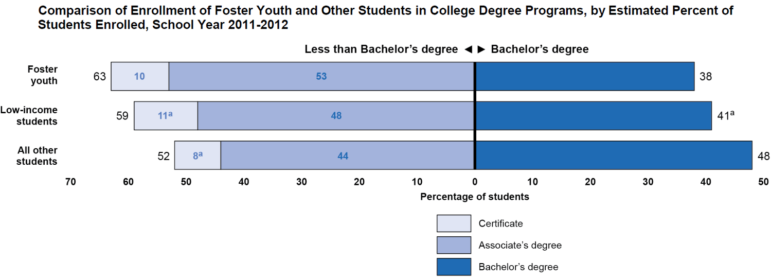
WASHINGTON — Burdensome paperwork requirements, limited academic preparation and a lack of adult guidance and support make it difficult for foster and homeless youth to pursue higher education, says a new report by the Government Accountability Office.
The GAO, an independent federal agency, called for streamlining federal rules that make it hard for youth to get financial aid or document their housing situation. It also urged studying how child welfare workers and others can better assist them with college planning.
Overall, about 14 percent of foster youth complete a bachelor’s degree within six years, compared with 31 percent of other students, according to federal data, GAO said. While less data is available about homeless students’ college completion rates, they have similar college enrollment patterns as foster youth, the report said.
Advocates hope the findings will encourage federal agencies and lawmakers to take steps to improve education access for foster and homeless youth.
[Related: California Law to Close Group Homes Stresses Importance of Family for Every Foster Kid]
“This very much validated our experiences, and hopefully this being in a GAO report will lend some urgency to executive and legislative efforts,” said Barbara Duffield, director of policy and programs at the National Association for the Education of Homeless Children and Youth.
The Higher Education Access and Success for Homeless and Foster Youth Act (S 2267) is a key piece of legislation that advocates hope lawmakers will take action on this year. The bill addresses many of the concerns identified in the GAO report, advocates say.
The GAO’s findings underscore the need for colleges and universities to improve outreach and resources, and for the federal government to streamline eligibility determinations for assistance, said Sen. Patty Murray, introduced the bill last year.
“Students from all walks of life should have the chance to pursue a college degree, especially because higher education can be a ticket to the middle class,” she said in a news release. The Democrat from Washington state is the ranking member of the Senate Health, Education, Labor and Pensions Committee.
Rep. Katherine Clark, D-Massachusetts, has introduced companion legislation in the House (HR 4043).
Duffield said the report stressed the role of child welfare workers and liaisons to homeless youth in schools to help students navigate college preparation and enrollment. However, she noted the positions are not entirely analogous.
The representatives for homeless youth in schools under the McKinney-Vento Education for Homeless Children and Youth Program don’t have the same authority or resources to meet students’ needs, as much as they may try, she said.
“They’re the lifeline, the only ones trying to provide basic services,” but they’re functioning in the absence of a robust system for homeless youth, Duffield said.
Jenny Pokempner, child welfare policy director at the Juvenile Law Center, said education is a critical way to help foster and homeless youth.
“When kids have the skills that can get them into careers, that will get them a living wage, we know that will help them transition into adulthood,” she said.
More related articles:
No Job, No Home, No Green Card: Crashing Into 21
Lost in the System: Girls, Foster Care and the Commercial Sex Trade in L.A. County
Better Collaboration Key to Helping Crossover Youth, Panelists Say






























